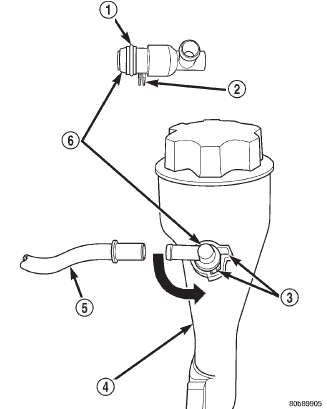 Dodge Durango Service ManualEmission Control Systems » Evaporative emission controls » Diagnosis and testing
Dodge Durango Service ManualEmission Control Systems » Evaporative emission controls » Diagnosis and testing
Pcv valve/pcv system test-4.7L v-8 engine
Pcv valve/pcv system test-4.7L v-8 engine
(1) Disconnect PCV line/hose (Fig. 18) by disconnecting rubber connecting hose at PCV valve fitting.
(2) Remove PCV valve at oil filler tube by rotating PCV valve downward until locating tabs have been freed at cam lock (Fig. 18). After tabs have cleared, pull valve straight out from filler tube. To prevent damage to PCV valve locating tabs, valve must be pointed downward for removal. Do not force valve from oil filler tube.
(3) After valve is removed, check condition of valve o-ring (Fig. 18). Also, PCV valve should rattle when shaken.
(4) Reconnect PCV valve to its connecting line/ hose.
(5) Start engine and bring to idle speed.
(6) If valve is not plugged, a hissing noise will be heard as air passes through valve. Also, a strong vacuum should be felt with a finger placed at valve inlet.
(7) If vacuum is not felt at valve inlet, check line/ hose for kinks or for obstruction. If necessary, clean out intake manifold fitting at rear of manifold. Do this by turning a 1/4 inch drill (by hand) through the fitting to dislodge any solid particles. Blow out the fitting with shop air. If necessary, use a smaller drill to avoid removing any metal from the fitting.
(8) Do not attempt to clean the old PCV valve.
(9) Return PCV valve back to oil filler tube by placing valve locating tabs (Fig. 18) into cam lock.
Press PCV valve in and rotate valve upward. A slight click will be felt when tabs have engaged cam lock.
Valve should be pointed towards rear of vehicle.
(10) Connect PCV line/hose and connecting rubber hose to PCV valve.
(11) Disconnect rubber hose from fresh air fitting at left side of air cleaner resonator box (Fig. 19).
Start engine and bring to idle speed. Hold a piece of stiff paper (such as a parts tag) loosely over the opening of the disconnected rubber hose.
(12) The paper should be drawn against the hose opening with noticeable force. This will be after allowing approximately one minute for crankcase pressure to reduce.
(13) If vacuum is not present, disconnect each PCV system hose at top of each breather (Fig. 19). Check for obstructions or restrictions.
(14) If vacuum is still not present, remove each PCV system breather (Fig. 19) from each cylinder head. Check for obstructions or restrictions. If plugged, replace breather. Tighten breather to 12 N*m (106 in. lbs.) torque. Do not attempt to clean breather (15) If vacuum is still not present, disconnect each PCV system hose at each fitting and check for obstructions or restrictions.
 Fig. 18 PCV Valve/Oil Filler Tube-4.7L V-8 Engine
Fig. 18 PCV Valve/Oil Filler Tube-4.7L V-8 Engine
1 - O-RING
2 - LOCATING TABS
3 - CAM LOCK
4 - OIL FILLER TUBE
5 - PCV LINE/HOSE
6 - PCV VALVE
VACUUM SCHEMATICS
A vacuum schematic for emission related items can be found on the Vehicle Emission Control Information (VECI) label. For label location, refer to Vehicle Emission Control Information (VECI) Label.
Pcv valve test-3.9/5.2/5.9L engine
Pcv valve/pcv system test-4.7L v-8 engine
Leak detection pump (ldp)
Dodge Durango Service Manual
- Lubrication and Maintenance
- Suspension
- Differential and Driveline
- Brakes
- Cooling System
- Battery
- Starting Systems
- Charging System
- Ignition System
- Instrument Panel Systems
- Audio Systems
- Horn Systems
- Speed Control System
- Turn Signal and Hazard Warning Systems
- Wiper and Washer Systems
- Lamps
- Passive Restraint Systems
- Electrically Heated Systems
- Power Distribution System
- Power Lock Systems
- Vehicle Theft/Security Systems
- Power Seat System
- Power Window Systems
- Power Mirror Systems
- Chime/Buzzer Warning Systems
- Overhead Console Systems
- Engine
- Exhaust System
- Frame and Bumpers
- Fuel System
- Steering
- Transmission and Transfer Case
- Tires and Wheels
- Body
- Heating and Air Conditioning
- Emission Control Systems
- Introduction
Categories
0.0219
